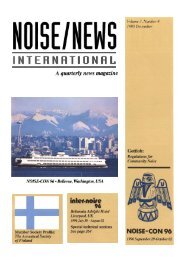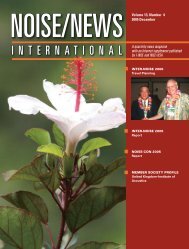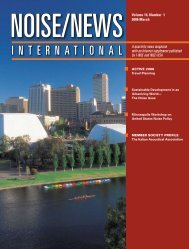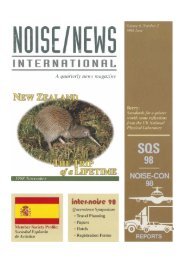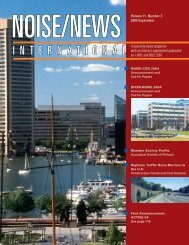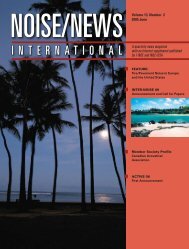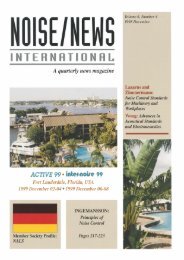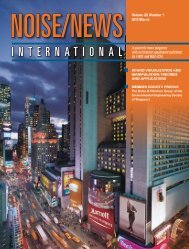Volume 15, Number 4, December, 2007 - Noise News International
Volume 15, Number 4, December, 2007 - Noise News International
Volume 15, Number 4, December, 2007 - Noise News International
- No tags were found...
Create successful ePaper yourself
Turn your PDF publications into a flip-book with our unique Google optimized e-Paper software.
ANSI Working Group,• Current and past ASA StandardsDirectors (Paul Schomer & DanielJohnson)• The Office of the ASA StandardsSecretariat, led by Susan Blaeser• Current and past ASA Presidents,and ASA Executive Director CharlesSchmid• The American Institute of Physics PublicRelations activity led by Ben Stein• Rank and file members of theAcoustical Society of America• William W. Lang and others in I-INCEworking toward national and globalpolicy to regulate community noise,including that impedes classroomlearning.If OSHA Won’tLead, Perhaps ItShould Follow!Robert D. Bruce, CSTIAcoustics, Texas<strong>Noise</strong>-induced hearing loss (NIHL) hasbeen an industrial problem in the UnitedStates for over 100 years. Governments,both state and federal, were slow to regulatenoise exposure. In addition, the authorityis scattered among a number of agenciesthat may have different regulations toaccommodate their particular industry.The following U.S. Agencies haveoccupational noise regulations:• Occupational Safety and HealthAdministration (OSHA) – oneregulation for manufacturing and onefor construction• Mine Safety and Health Administration(MSHA)• Coast Guard• Federal Railway Administration (FRA)• U. S. Department of DefenseThe current noise level limit for nonmilitaryworkers is 90 dBA with a 5 dBexchange rate, and for military personnel itis 85 dBA with a 3 dB exchange rate.Prevention in the form of hearingprotection is not assured, as workersmay not know how to properly wearthis protection and it may not alwaysbe available. Although the federalgovernment requires manufacturersto label their earplugs with the NRR(noise reduction rating), the NRR doesnot represent the typical noise reductionachievable in practice in the workplace.NRRs of 20-30 are common but fewworkers get more than 10-12 dBA of noisereduction using hearing protection duringtheir workday. Perhaps thegovernment should considera better labeling alternativeor a different approach toprotecting workers’ hearing.(The labeling requirement isbeing revised.—Ed.)When a worker suffers fromNIHL, it is usually familymembers who first recognizethe problem. Eventually the problem getsso bad that individuals can no longer denyit, and they see an audiologist or physicianto confirm that it is permanent hearing lossand often it is diagnosed as noise inducedhearing loss.Mild hearing loss is similar to mildasthma—annoying but not critical.As hearing worsens, it becomes likethe chronic pain of a slipped disc andeventually severe hearing loss can belikened to continuous pneumonia. Witheven mild hearing, one may not hearhigh-frequency speech sounds andmay not understand soft-spoken voicesin reverberant or noisy spaces (e.g.restaurants). The person often cannotmaintain conversations and, as a result,may give up on friendships because theycan’t hear well enough to carry on aconversation. Obviously, they can feelsocially isolated from others.At the beginning of the 20th century, about20% of the jobs were white-collar. Oftenworkers would move from noisy jobs toCivilian hearing losscompensation was 56million USD in 2003, andthat number is rising.quieter jobs in lower level management andeven to higher positions. At the beginningof the 21st century, about 60% of the jobswere white collar. There is an expandingopportunity for white-collar workers. Butif a worker has spent 10–20 years in anoisy occupation and has hearing loss, hisopportunity for a white-collar position maybe limited because almost all white-collarjobs require good hearing.As life spans increase, workers at age 50with extensive noise exposure will have“80-year old ears.” Whenthey reach 80 years, willthey have any hearing left?This is definitely a qualityof-lifeissue. Are we headedtoward an older, deafer,depressed male population?Unfortunately this is reallyabout money and whereit is spent. Currentlymuch of the spending is in the form ofcompensation after NIHL is diagnosed.Military compensation for hearing-lossdisability for veterans has amounted to $7.6billion over the past 30 years. Civilianhearing loss compensation was $56 millionin 2003, and that number is rising. Nonmilitarybenefits for workers are usuallycovered by Workers’ Compensation butmay vary by state and are likely to beless than $10,000. In addition, workerswith hearing loss have sued employersand third-party manufacturers of noisymachinery and equipment.Perhaps a new approach should be tried:spend the money before workers lose theirhearing by purchasing quiet equipmentand controlling noise at the source. Twomajor corporations whose expenditures onequipment and facilities exceed $<strong>15</strong> billionnow have new limits on the noise levelof new purchases. Because current andextensive hearing protection programs havenot been adequate, industry must seriouslyconsider buying quieter equipment toprevent hearing loss in workers. OSHA’s<strong>2007</strong> <strong>December</strong> www.inceusa.org • www.noisenewsinternational.net • www.i-ince.org143



